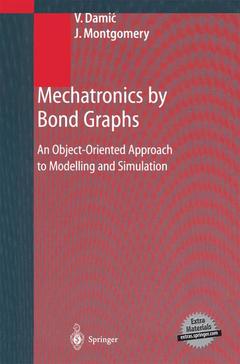Mechatronics by Bond Graphs An Object-Oriented Approach to Modelling and Simulation
Langue : Anglais
Auteur : Damic Vjekoslav

Bondgraphs are a well-established technique for the modelling of complex engineering systems. The subject of this book is an integrated modelling and simulation of mechatronics systems in a visual computer environment. The modelling is based on system top-down and bottom-up approach. The mathematical models are generated in a form of differential-algebraic equations and solved using numerical and symbolic algebra methods. The integrated approach developed is applied to mechanical, electrical and control systems, multibody dynamics, and continuous systems. The book contains a powerful computer simulation package on the accompanying CD-ROM.
1 Fundamentals.- 1 Basic Forms of Model Representation.- 1.1 Objectives.- 1.2 The General Modelling Approach.- 1.3 Physical Modelling, Analogies, and Bond Graphs.- 1.4 Block Diagrams.- 1.5 Symbolic Model Solving.- 1.6 The Object-oriented Approach.- 1.7 Computer Aided Modelling.- 1.8 The Book Summary.- References.- 2 Bond Graph Modelling Overview.- 2.1 Introduction.- 2.2 Word Models.- 2.3 Ports, Bonds, and Power Variables.- 2.4 Component Model Development.- 2.5 Modelling Basic Physical Processes.- 2.5.1 Elementary Components.- 2.5.2 The Inertial Component.- 2.5.3 The Capacitive Component.- 2.5.4 The Resistive Component.- 2.5.5 Sources.- 2.5.6 The Transformer and The Gyrator.- 2.5.7 The Effort and Flow Junctions.- 2.5.8 Controlled Elementary Components.- 2.6 Block Diagram Components.- 2.6.1 The Input Component.- 2.6.2 The Output Component.- 2.6.3 The Function Component.- 2.6.4 The Integrator.- 2.6.5 The Differentiator.- 2.6.6 The Summator.- 2.6.7 The Node.- 2.7 Modelling Simple Engineering Systems.- 2.7.1 Simple Body Spring Damper System.- 2.7.2 The Simple Electrical Circuit.- 2.7.3 A See-saw Problem.- 2.8 Causality of Bond Graphs.- 2.8.1 The Concept of Causality.- 2.8.2 Causalities of Elementary Components.- 2.8.3 The Procedure for Assigning Causality.- 2.9 The Formulation of the System Equations.- 2.10 Causality Conflicts and Their Resolution.- References.- 3 Object-oriented Approach to Modelling.- 3.1 Introduction.- 3.2 The Component model.- 3.2.1 The Component Class.- 3.2.2. The Document class.- 3.3 The Component Class Hierarchy.- 3.4 Port and Bond Classes.- 3.5 Description of the Element Constitutive Relations.- 3.6 Modelling Vector and Higher-dimensional Quantities.- 3.7 Port Connection Rules.- 3.8 The Component Set Classes.- 3.9 Systematic Top/down Model Development.- 3.10 Component Libraries and Model Reuse.- References.- 4 Object Oriented Modelling in a Visual Environment.- 4.1 Introduction.- 4.2 The Visual Environment.- 4.3 The Component Hierarchy.- 4.4 The Port and Bond Classes Hierarchy.- 4.5 The Document Architecture.- 4.6 Editing Bond Graphs.- 4.6.1 The Bond Graph Palette.- 4.6.2 Creating Components and Ports.- 4.6.3 Creating Bond Lines.- 4.6.4 Editing Bond Graph Models.- 4.6.5 Editing Electrical and Mechanical Schemas.- 4.7 Important Operations at Document Level.- 4.7.1 The Open, Close, and Save Commands.- 4.7.2 The Copy, Cut, Insert, and Delete Operations.- 4.7.3 Library Operations.- 4.7.4 The Page Layout and Print Commands.- 4.8 Editing The Component Constitutive Relations.- 4.8.1 Component Port Dialogues.- 4.8.2 Defining the Parameters.- 4.9 Collaboration Support.- References.- 5 Generation of the Model Equations and Their Solution.- 5.1 Introduction.- 5.2 General Forms of the Model Equations.- 5.2.1 System Variables.- 5.2.2 Generation of the Equations.- 5.2.3 The Characteristics of the Model.- 5.3 Numerical Solution Using BDF Methods.- 5.3.1 The Implementation of the BDF Method.- 5.3.2 The Generation of the Partial Derivative Matrix.- 5.3.3 The Error Control Strategy.- 5.4 Decompiling of the Model Equations.- 5.5 The Problem of Starting Values.- 5.6 The Treatment of Discontinuities.- 5.7 Pros and Cons of the Combined Compiled/Interpretative Approach.- References.- 2 Applications.- 6 Mechanical Systems.- 6.1 Introduction.- 6.2 The Body Spring Damper Problem.- 6.2.1 The Problem.- 6.2.2 The Bond Graph Model.- 6.2.3 Analysis of the System Behaviour by Simulation.- 6.3 Effect of Dry Friction.- 6.3.1 The Model of Dry Friction.- 6.3.2 Free Vibration of a Body with Dry Friction.- 6.3.3 Stick-Slip Motion.- 6.3.4 The Stick-Slip Oscillator.- 6.4 Bouncing Ball Problems.- 6.4.1 Simple Model of Impact.- 6.4.2 A Ball Bouncing on a Table.- 6.4.3 Ball Bouncing on a Vibrating Table.- 6.5 The Pendulum Problem.- References.- 7 Electrical Systems.- 7.1 Introduction.- 7.2 Electrical Circuits.- 7.3 Models of Circuit Elements.- 7.3.1 Resistors.- 7.3.2 Capacitors.- 7.3.3 Inductors.- 7.3.4 Independent Sources.- 7.3.5 Dependent Sources.- 7.3.6 Switches.- 7.4 Modelling Semiconductor Components.- 7.4.1 Diodes.- 7.4.2 Transistors.- 7.4.3 Operational Amplifiers.- 7.5 Electromagnetic Systems.- 7.5.1 Electromagnetic Actuator Problem.- 7.5.2 System Bond Graph Model.- 7.5.3 Electromagnetic Flux and Force Expressions.- 7.5.4 Magnetic Actuator Component Model.- 7.5.5 Simulation of Magnetic Actuator Behaviour.- References.- 8 Control Systems.- 8.1 Introduction.- 8.2 A Simple Control System.- 8.3 Control Systems Modelling.- 8.4 Permanent Magnet DC Servo System.- References.- 9 Multibody Dynamics.- 9.1 Introduction.- 9.2 The Modelling of a Rigid Multibody System in a Plane.- 9.2.1 The Component Model of a Rigid Body in Planar Motion.- 9.2.2 Joints.- 9.2.3 Modelling and Simulation of a Planar Mechanism.- 9.3 Andrews’ Squeezer Mechanism.- 9.4 Engine Torsional Vibrations.- 9.5 Motion of Constrained Rigid Bodies in Space.- 9.5.1 Basic Kinematics.- 9.5.2 Bond Graph Representation of a Body Moving in Space.- 9.5.3 Rigid Body Dynamics.- 9.5.4 Modelling of Body Interconnections in Space.- 9.6 Motion of an Anthropomorphic Robot Arm Under Hybrid Control.- 9.6.1 Problem Formulation.- 9.6.2 Model of the Robot System.- 9.6.3 Hybrid Position/Force Control.- 9.6.4 The Simulation of the Robot Motion.- References.- 10 Continuous Systems.- 10.1 Introduction.- 10.2 Spatial Discretisation of Continuous Systems.- 10.3 Model of Electric Transmission Line.- 10.4 Bond Graph Model of a Beam.- 10.5 A Packaging System Analysis.- 10.5.1 Description of the Problem.- 10.5.2 Bond Graph Model Development.- 10.5.3 Evaluation of Vibration Test Characteristics.- 10.6 Coriolis Mass Flowmeter.- 10.6.1 Principle of Operation.- 10.6.2 Bond Graph Model of the Meter.- 10.6.3 Evaluation of the Meter Sensitivity Factor.- References.
Computer-aided practical approach to the design of mechatronic systems
Contains a working version of the powerful simulation software BONDSIM on CD-ROM
The bondgraph method as well as the use of the software are explained by examples of typical mechatronic systems
Contains a working version of the powerful simulation software BONDSIM on CD-ROM
The bondgraph method as well as the use of the software are explained by examples of typical mechatronic systems
Date de parution : 04-2014
Disponible chez l'éditeur (délai d'approvisionnement : 15 jours).
Prix indicatif 91,77 €
Ajouter au panier
© 2024 LAVOISIER S.A.S.



